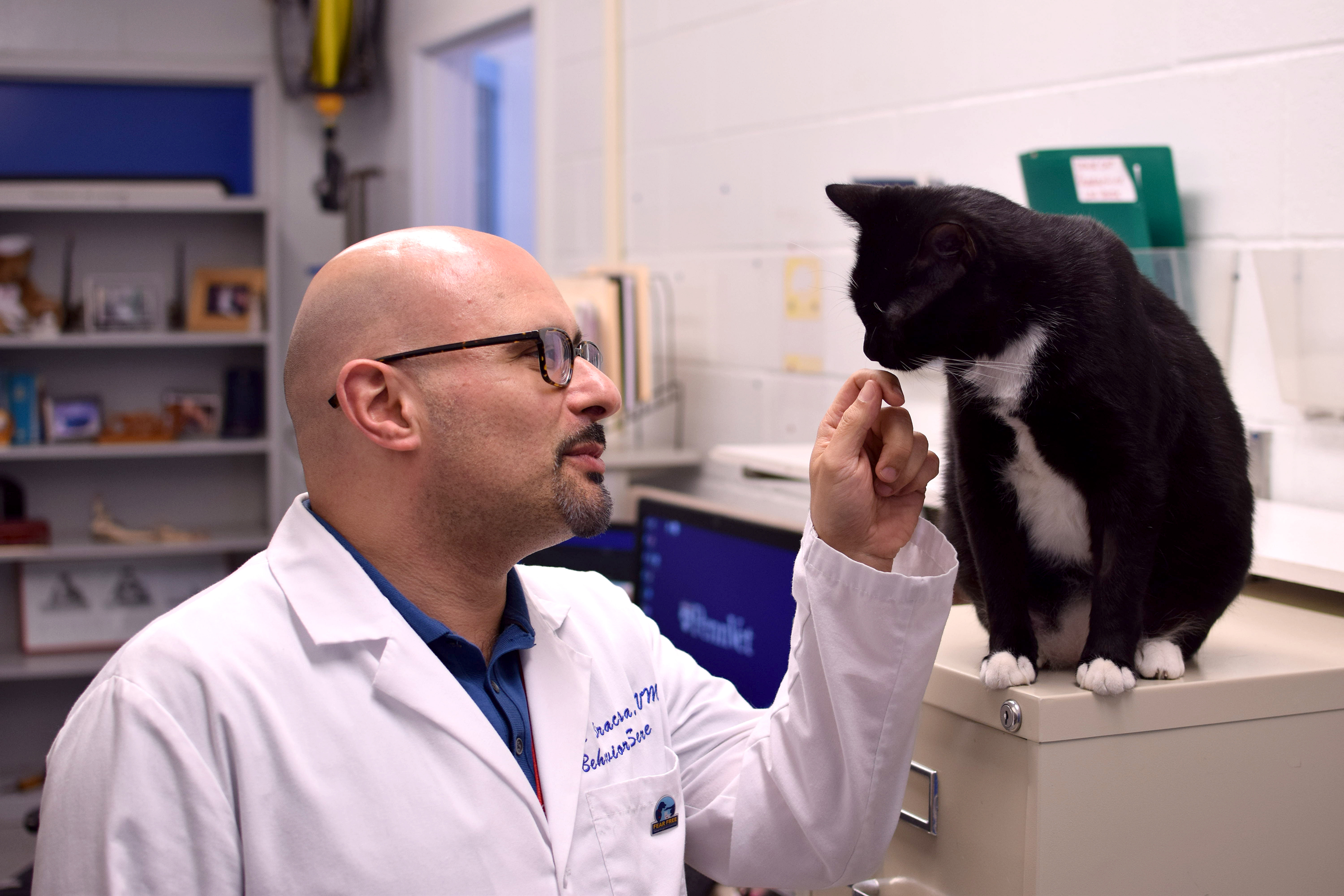
They know their names. We can read their facial expressions, sort of. And some of them really like having us around. These are among the purported findings of recent scientific studies aimed at deciphering the behavior of some of our most mysterious yet ubiquitous companions: pet cats.
Yet research into cat behavior is extremely limited, and, according to veterinary behavior expert Carlo Siracusa and animal ethics and welfare professor James Serpell of Penn’s School of Veterinary Medicine, the mainstream media—and sometimes scientists themselves—have a habit of overinterpreting such studies.
So, what do we know about cat behavior? To mark National Cat Health Month, and the upcoming publication of “Decoding Your Cat,” a book Siracusa co-edited to give cat owners access to digestible, yet science-based information, Penn Today spoke with Siracusa and Serpell about their own research on cat behavior and their thoughts on the field.
The conversation, driven by Siracusa’s and Serpell’s scientific and clinical expertise and peppered with anecdotes from their own experiences as cat owners, helps contextualize recent findings in cat behavioral science, underscores why cats are far from “low-maintenance dogs,” and offers guidance for cat owners.


One study of cat behavior showed that cats recognize their names, and another showed they can bond securely to their owners. Overall, however, there seem to be a lot more studies of dog behavior. Why is that?
Siracusa: Even though I consider myself a cat person, most of the work that I’ve done is on dogs because that’s where the funding is. In our behavior clinics we see many fewer cats than dogs, I’m talking like 95% dogs and 5% cats. I think this is related in part to the fact that there is much less expectation for cat behaviors. If you have a dog growl and bark at everyone who comes to your apartment, that’s a major problem, but if your cat hisses and then runs and hides, nobody cares.
Serpell: Studies show that people are on average less attached to their cats and spend less money on their cats. Cats are numerically more common than dogs in the United States, but there are fewer cat-owning households than dog-owning households, which means that people may be owning more than one cat and thus have less to spend on each one.
But recently the Morris Animal Foundation sent a survey to veterinarians around the country and asked what they consider to be areas of primary importance that they needed help with. Almost at the top of the list was cat behavior problems.
So, I think people are getting on board slowly with the idea that pet owners are becoming more attached to their cats and that they are becoming much more significant members of people’s social groups.
Is there something intrinsic to cats that explains this lack of attention to behavioral science compared to dogs?
Siracusa: Dogs evolved from a social species, whereas cats come from an ancestor that was solitary. I don’t think they’ve evolved a social behavior as complex as dogs’ social behavior. And maybe as a result it’s harder for people to understand cats’ social behavior since it’s mostly based on distance and nonprolonged contact. That’s why when you put cats in a small environment, like an urban apartment, especially with other cats, you may run into problems.
Serpell: But cats have lived with humans now for about 9,500 years. That’s a long time, and they’ve evolved to be more tolerant of living in close proximity with people and with other cats.
There’s all this evidence now coming out about dogs having a gene mutation equivalent to Williams syndrome in humans, which causes hypersociality. I suspect that we might find some of that in domestic cats. These animals are much more sociable than their wild ancestors.
You have a wealth of data about cat behavior from Fe-BARQ [the Feline Behavioral Assessment and Research Questionnaire, developed by Serpell]. What are some of the things that the data tell you about cats and their relationship with people?
Serpell: From our Fe-BARQ data we see that a surprising number of owners are reporting moderate to severe behavioral problems in a cat when separated from its owner. So much for the theory that cats don’t really care about their owners, that they’re only there for their food; these cats really do seem to be distressed from being away from their human buddies.
Siracusa: We see this in clinics. For example, cats may eliminate or vomit if they’re left alone for more hours than usual. So, I think they are definitely attached to people. But the way they’re showing they’re attached is very different from dogs. Dogs make a lot of prolonged physical contact, whereas cats may stay close to the person they like, but they don’t necessarily engage. Some cats may engage a little—one of my cats plays fetch with me—but only for a short time, and then she’s like, ‘Oh, I’ve had enough of this.’
Do you think that cats are more varied in their sociability than dogs?
Serpell: I do. Some cats, as soon as you sit down, they’ll be on your lap, and they’ll monopolize you, but others won’t at all. One of my cats loves people; when you arrive at the door, she rushes to the door, and she rubs against you. But she hates being picked up, and she does not want to sit on you ever. Whereas her brother is much more physically affectionate. He wants to be held; he wants to sit on people.
There are very few dogs I've met that are standoffish the way a cat is often.
Cat behavior can be puzzling. Is the problem that people just aren’t good at interpreting their cat’s behavior?
Siracusa: People really do need help understanding their cats’ behavior, and they don’t know where to go or who to ask about these problems. In a recent survey, somewhere between 50 and 60% of cat owners said, ‘I have problems bringing my cat to the vet,’ or ‘My vet doesn’t understand the problems of my cat,’ or ‘I will only bring my cat to the vet when it’s strictly necessary.’ For many cat owners, just picking a cat up and putting it in the crate is a major drama.
Serpell: Of course, many dogs also don’t like to go to the vet, but dogs are more biddable; they’ll just go along with it. But cats, boy. I had to bring both of my cats in a week ago, and it was an ordeal.
Siracusa: I do think cats are very sensitive to changes in their environment.
Serpell: Some of it may relate to the fact that cats are a prey species as well as being a predator. Being in an unfamiliar environment is potentially very unsafe for them, so it’s natural for them to go, ‘Oh, crikey, where am I, and what’s going to come at me next?’
What are some of the big myths or misperceptions about cat behavior?
Siracusa: Many people want a cat to be a surrogate for a dog, like a low-maintenance dog, and it’s not.
Another misperception is that because cats are so fluffy and soft, people like to touch them a lot, but cats don’t necessarily like this. Some do—some that I’ve had were always on top of me—but others were like, ‘Ok, we’re friends, but you stay there, and I stay here.’ So, it’s a matter of respecting their desire for distance in those cases.
Also, people often fail to provide cats with enough stimulation. It’s important to give them opportunities to show their natural feeding behavior, for instance. So instead of simply putting their food in a bowl, give them a chance to stalk it, to toss it in the air and pounce, and reproduce the whole sequence of events that they would do when they hunt.
How do you try to correct clients’ misguided impressions about cats?
Siracusa: [Laughing] This is the reason our behavior appointments are very long. We try to set realistic expectations, and we provide them with alternative strategies. For example, if you want a nice interaction with your cat, use something cats like. Teach them to do a trick to get a treat. Use a stick-and-feather toy.
Serpell: Some cats will play for hours. My cats, they exhaust me. They’ll run all around the house for hours with a piece of string.
Siracusa: Sometimes I say, ‘If you need to hug something, get a stuffed toy.’ Don’t do that to your cat if she doesn’t like it.
The one recent study about cats showed the same or an even greater degree of attachment to their owners as dogs have. You seem skeptical about those findings.
Serpell: Carlo is more than I am.
Siracusa: I think the methodology is rigorous. But I’m skeptical because the study assumed that the vocalization of the cats indicated separation distress. I think it’s very likely to be distress from being in an unfamiliar environment, but I’m not convinced that it’s separation distress.
Serpell: Speaking on behalf of the article, I would say that there is a perception out there— another one of these myths, if you like—that cats aren’t really attached to their owners, that they’re only there to get fed. I think this study is a demonstration that cats respond similarly to this experimental paradigm as do dogs and for that matter as do human infants, and that's interesting, just in itself.
What about the study suggesting cats recognize their name?
Siracusa: I think this study is similar; the experiments seem rigorously done, but the results are prone to overgeneralization. For cats it’s not, ‘Oh, my name is Jack.’ It’s, ‘Usually when I hear this word something is about to happen.’
Serpell: It’s a demonstration that the cat has some kind of association with this sound. I think that’s right; my cats respond to their names. But it’s different from what we’ve seen in dogs, some of which have amazing vocabularies and can discriminate between more than a thousand different words.
Have you seen the ‘cat whisperer’ quiz that’s going around, based on a recent publication about cat facial expressions?
Serpell: It sounds dubious. Cats lack the facial muscles that dogs have so they’re limited in the expressions they can make.
Siracusa: Because cats in general were solitary animals evolutionarily, staying at a distance from one another, the facial expressions wouldn’t have been so important in communicating. If I want to communicate with someone who is far away, I wouldn’t show it on my face but in my body, my posture.
Serpell: The sense of smell.
Siracusa: Smell, definitely. Pheromones are very important. Also, they leave visual signs. The scratching of a cat is a visual sign to leave a message for someone who didn’t find them but will find the scratch.
It sounds like the book you have coming out soon might also help pet owners interpret their cats.
Siracusa: Yes, ‘Decoding Your Cat’ is coming out in June. It’s a project of the American College of Veterinary Behaviorists, and all the chapters are written by diplomates of the College and edited by myself and two of my colleagues. Our goal was to make sure as much as possible was science-based, and the information that hasn’t been studied was based on our clinical experience.
What is on the horizon in terms of cat behavior research?
Siracusa: Cat cognition studies will be the next big thing.
Serpell: Yes, there are some groups now that are starting to get interested in cat cognition, but it’s still way behind dogs. There are so many dog cognition groups now around the world it’s almost funny.
How might studies of cat cognition be helpful?
Serpell: Well, it would be interesting to see whether the process of domestication has shifted the cat cognitively in the way that people say it’s shifted the dog.
Siracusa: It may help with the animals’ welfare, too, because if we understand them better, we can make sure we create an environment for them that will make them happier in their homes.
James Serpell is the Marie A. Moore Professor of Ethics and Animal Welfare and director of the Center for the Interaction of Animals and Society at the University of Pennsylvania School of Veterinary Medicine.
Carlo Siracusa is associate professor of clinical behavior medicine at the University of Pennsylvania School of Veterinary Medicine.
To contribute to Penn Vet’s cat behavior research: Fe-BARQ online survey.







